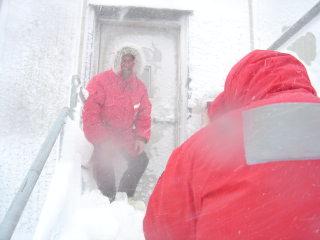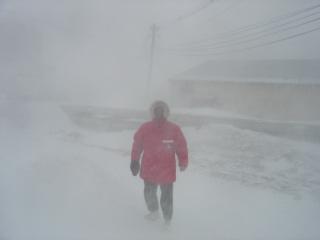3 December, 2003
This just in......
Hello from beautiful downtown McMurdo! Today is December 2nd and yes, I know the journal entry says December 3rd, but I was expecting to be in transit to the Beardmore Glacier YESTERDAY, and wanted to be one day ahead in journal entries so I could devote the travel day to getting our Field Camp set up. However we are in our second day of CONDITION 2 and it looks like we will not be on our way for a couple more days. Our team has been ready to deploy for several days now, so this turn in the weather has us just a wee bit upset, we are very anxious to get into the field. In fact, we have discussed the possibility of working in shifts around the clock once we get into the field to make up for this lost time.
Right now, all around us is Condition 1, which I will explain by pasting the following from the McMurdo Intranet:
Weather Condition 3 Travel is unrestricted within McMurdo complex. Foot travel outside of the McMurdo complex is unrestricted, with the exception of the above-restricted areas. Until the shuttle service is running regularly to Williams Field check out with the Firehouse is required to walk to Williams Field. If shuttle service is running regularly to the Ice Runway, check out is not required.
Weather Condition 2 Foot travel is restricted to the McMurdo complex. It is recommended that foot travel be conducted in pairs whenever possible or practical. Recreational travel to the extremities of the McMurdo complex (Hut Point, the Pass, the old Water Plant etc.) is prohibited. Travel outside the McMurdo complex is limited to work related vehicular travel.
Weather Condition 1 ALL OUTDOOR TRAVEL is PROHIBITED with the following exceptions:
a. When authorized travel in pairs utilizing safety lines between dorms and B155 for meals.
b. Travel by three (patient plus two others), utilizing safety lines, between B155 and Medical for non-life threatening medical problems.
c. ALL OTHER TRAVEL MUST BE APPROVED BY: RPSC Area Manager or NSF Station Manger for the other respective agencies on a case-by-case basis.
In discussion among ourselves, we decided that the powers that be did not raise it to Condition 1 for one of two possible reasons: One, this isn't really that bad for Antarctic regulars, or two: They did not want to lock down that many people in their respective buildings. I mean, you can make it from building to building if you get a good bead on it before you leave the comfort of the one you are in!
Presently, we are seeing steady winds of 78 miles per hour, with gusts to 94. The temperature outside is 24 degrees F. making the wind-chill -41 F. I went outside to shoot a picture of my colleague, Dr. Philip Currie, and in just 3 minutes outside the lab, my pockets were filled with snow! Also, although the temperature is in the twenties, the windblown snow quickly melts on your warm hands (exposed to use the camera) the wind-chill soon makes your hands quite useless and in danger of frostbite. (Now I wish I had taken the time to sew up that special camera-mitt I designed)
Probably the most dangerous part about being out side in these conditions is the danger of not being seen, or in seeing. The ECW (Extreme Cold Weather) gear is quite warm and does a great job blocking the wind so you really are well insulated against the wind and cold but with your hood up and snorkeled down, your vision is restricted. As you walk, you must move your head from side to side and do a pirouette from time to time to keep aware of your surroundings and look out for vehicles. This is because besides the limited visibility, the wind is so loud, that you cannot hear anything above it except for those voices in your head asking you if this is really a good thing to be doing? You also have to keep sure footing because an occasional big gust of wind can knock you right over if it catches you unprepared. I have witnessed several such happenings to folks walking from the dorm to the Science Support Center where the road has been blown clear of loose snow and just the hard pack remains. It is amazing to see people use the glacier travel self-arrest techniques they learned in snow school on the streets of McMurdo!
Other than that, life inside is pretty much as usual, except for the roar of the wind that penetrates the thick walls of the buildings and the occasional creak and bang, you would not know anything unusual is going on. Work continues, people go about their tasks and in general, life goes on at McMurdo Station. I have been aware of a lot of sirens going off which I have been told is due to false alarms being triggered by the wind and snow interfering with the detectors and alarm systems.
With all this extremely nasty weather, I do wonder how the Antarctic animals deal with these conditions; you know they do because they are here. I have observed the animals in high winds before, but usually with sunny skies. The seals and penguins find shelter behind a snow dune or rock and orient themselves with the wind but in this condition, there is no shelter that I can see. Even behind a building in the lee of the wind, there is no escape from the swirling winds and stinging snow. As my Dad would say "Tis' no night for man nor beast." And even though we have 24 hours of daylight, I don't think I want to venture out to see. The great thing about being here at the Crary lab is that you can find an expert on the subject pretty easily.
This just in: As I am finishing this piece, they just passed the word that they dropped us to Condition 1. This means no travel except by safety lines between buildings. This will be the first time I will have to rope up just to eat! But I guess this is no joke, I just went upstairs to the library and the exit doors have big signs on them prohibiting leaving except in case of fire! At least we have plenty of books and "Cup of Soup" packs to weather this one out!
So take care and enjoy life. Even as wild as it may seem here right now, this is an experience of a lifetime that I would never trade for anything. (Well maybe for a seat on the next shuttle mission.)
Cheers,
Andy

At the door to the Crary Lab

Standing 10 feet form the camera in a Condition 2.

Dr. Philip Currie stands in front of the National Science Foundation Administration building during a Condition 2.
Contact the TEA in the field at
.
If you cannot connect through your browser, copy the
TEA's e-mail address in the "To:" line of
your favorite e-mail package.
|
